The backyards of Maine are full of interesting birds! Weather you live in Portland, Augusta or any other large city you will likely have seen some of the birds I will go through in this post.
In the last 30 years, especially four species have been dominant in Maine backyards: Black-capped Chickadee, the Mourning Dove, the American goldfinch and the Blue Jay. Despite their high total numbers, some have been more widely present at feeder than the others.
For example, whereas the White-Breasted Nuthatch has been observed at 83 percent of feeders, it only makes up 3.4% of total individual bird counts, which can be interpreted as each pair of Nuthatches visit more feeders.
With its long coast line, lakes and spruce forests, Maine is home to numerous bird species. For birdwatchers, the backcountry of Maine offers unique opportunities to observe birds that depend on the sea as well as the forest and houses migratory birds such as Gray Jays, Vireos, Warblers, Terns and Kingfishers.
If you are lucky, some of these birds may pay a visit to your backyard if you set up a proper bird feeder! In the bird descriptions below, I will guide you through how to attract and feed your favourite bird species – and how to avoid the annoying ones!
Contents
Statistics of backyard bird feeder visits in Maine
| Bird | Percent of total bird count | Percent of backyards visited | Average number of birds pr. visit | |
| 1 | Black-capped Chickadee | 11.5% | 96.6% | 4 |
| 2 | White-breasted Nuthatch | 3.4% | 83% | 2 |
| 3 | Downy Woodpecker | 3.3% | 77.7% | 2 |
| 4 | Tufted Titmouse | 5% | 76.7% | 2 |
| 5 | Blue Jay | 10% | 74.8% | 5 |
| 6 | Mourning Dove | 12.4% | 74.2% | 6 |
| 7 | Hairy Woodpecker | 2.7% | 67.7% | 1 |
| 8 | Red-breasted Nuthatch | 2.8% | 65% | 2 |
| 9 | Northern Cardinal | 3.3% | 58.8% | 2 |
| 10 | American Goldfinch | 7.9% | 57.7% | 5 |
| 11 | Dark-eyed Junco | 6% | 53.8% | 4 |
| 12 | American Crow | 3.3% | 36.5% | 3 |
| 13 | Red-bellied Woodpecker | 1% | 33.5% | 1 |
| 14 | House Finch | 2.2% | 24.6% | 3 |
| 15 | Eastern Bluebird | 1.8% | 21.5% | 3 |
| 16 | European Starling | 2.5% | 17.6% | 5 |
| 17 | Song Sparrow | 0.8% | 17.3% | 2 |
| 18 | White-throated Sparrow | 0.9% | 16.3% | 2 |
| 19 | Wild Turkey | 3.5% | 13.4% | 10 |
| 20 | American Robin | 1.3% | 12.4% | 4 |
| 22 | House Sparrow | 1.4% | 10.1% | 5 |
| 21 | Brown Creeper | 0.3% | 10.1% | 1 |
| 23 | Carolina Wren | 0.3% | 8.2% | 1 |
| 24 | Red-winged Blackbird | 1% | 7.9% | 5 |
| 26 | Common Grackle | 1.2% | 6.4% | 7 |
| 25 | American Tree Sparrow | 0.5% | 6.4% | 3 |
| 27 | Common Redpoll | 2.3% | 5.9% | 14 |
| 28 | Purple Finch | 0.4% | 5.8% | 2 |
| 29 | Evening Grosbeak | 1.5% | 5.4% | 11 |
| 30 | Chipping Sparrow | 0.2% | 5% | 2 |
Trends from bird feeder observations in backyards of Maine

From the frequency rankings show in the table above, the chickadee, titmouse, woodpeckers and nuthatches are especially likely to visit Maine backyards. This may be explained by the vast areas of spruce forest able to house these species in Maine.
From the trend statistics presented in this post we see some interesting trends in bird counts and bird feeder visits for Maine:
- Being very abundant, the Black-capped Chickadees in Maine backyards is keeping fairly constant. It may be taken over by the White-breasted Nuthatch, the Tufted titmouse or the Northern Cardinal in the coming years 10-20 years.
- The Tufted Titmouse is rapidly increasing its numbers in Maine backyards and the counts have almost doubled in the last 20 years.
- The Tufted Titmouse always shows up in pairs at Maine bird feeders, which is typical for monogamous non-migratory birds like the Tufted Titmouse.
- Today, the Mourning Dove arrives in flocks of approximately half the size of what they were 25-30 years ago in Maine.
- The Northern Cardinals are getting more common in Maine, with feeder visits doubled every ten years on average.
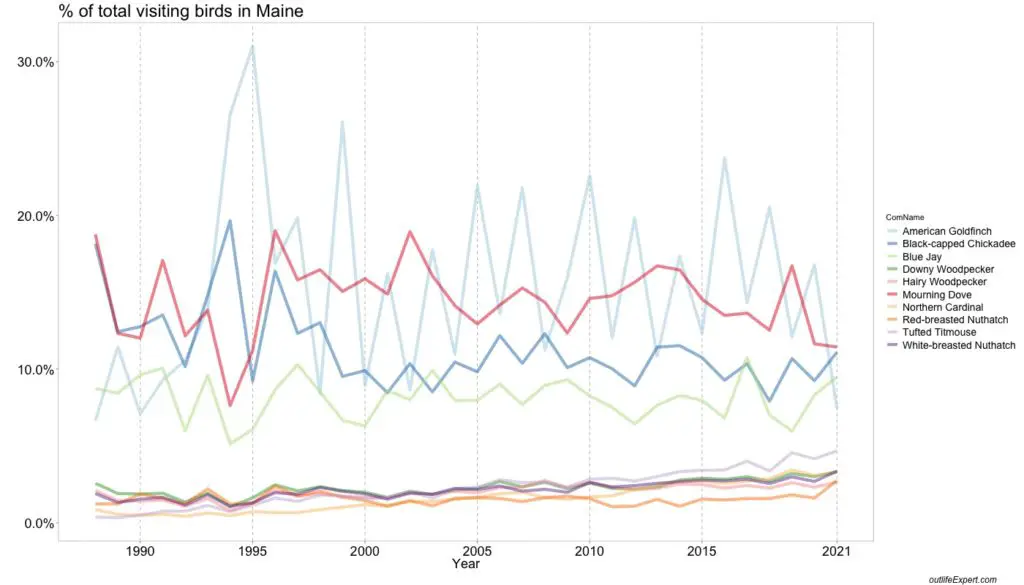
Read on to find out more facts about the most common backyard birds in the state of Maine!
1. Black-capped Chickadee (Poecile atricapillus)
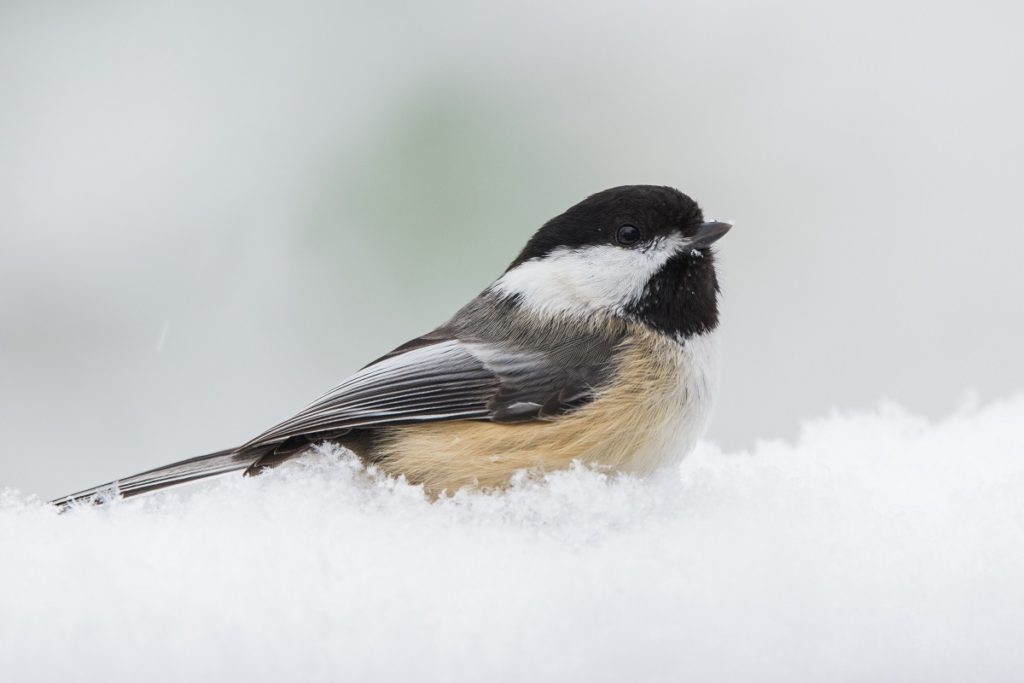
Black-capped Chickadee summary:
Family: Paridae
Occurrence: Canada, mostly Northern US and some central parts.
Diet in the wild: Insects, seeds, berries.
Feeder type preferences:
- Large tube feeder
- Ground feeder
- Suet Cage
- Small hopper feeder
- Large hopper feeder
- Platform feeder
- Window feeder
Feeder food preferences:
- Black Oil Sunflower Seeds
- Hulled Sunflower Seeds
- Safflower
- Mealworms
- Crushed peanuts
- Whole peanuts
- Nyjer seeds
- Suet
Endangered: No.
% of Maine feeders visited: 96%
Average flock size seen in Maine: 4
% of total birds at Maine bird feeders: 11%
These curious little birds are quick to discover birdfeeders and habituate to human presence. They can even learn to eat from a person’s hand!
In winter they form large flocks mixed with other bird species. They prefer mixed and deciduous forests, especially along the edges. However, they also do well in suburban areas with sufficient tree cover.
Their distribution spans from southern Alaska to Newfoundland, and to the south from Oregon to New York and inland as far south as Colorado and Kansas. They are the state bird of Massachusetts and Maine and the provincial bird of New Brunswick.
As birds with a more northerly distribution, they are especially cold tolerant. They survive cold winter nights by seeking cover in thick vegetation or cavities and by going into a hibernation-like state where they reduce their body temperature and metabolic rate to save energy. The presence of bird feeders increases their survival during winter months, especially in the northern parts of their distribution.
Black-capped chickadees belong to the Paridae family which also contains tits, and titmice. They can hybridize with Carolina chickadees or mountain chickadees where their ranges overlap. Other North American chickadees include the grey-headed chickadee, the chestnut-backed chickadee, the boreal chickadee, and the Mexican chickadee.
Identifying the black-capped chickadee
The black-capped chickadee is 5 to 6 inches with grey upper parts, light undersides, rusty flanks, white cheeks, and a black cap and bib. They can make many different sounds, including the distinctive call they were named after: “chick-a-dee-dee-dee”.
The Carolina chickadee looks similar but has a more southerly range and less white edging along its wing feathers. Even though the Carolina chickadee’s call is different, both birds can learn each other’s song, making it difficult to tell them apart where they co-occur. The mountain chickadee has a black eye stripe and a white brow. The boreal chickadee in Canada has a brown cap, instead of black and the chestnut-backed chickadee, as the name suggests, has a chestnut-colored back.
Mating and favorite foods of the black-capped chickadee
Their breeding season is from late April to June. They nest in nest boxes or cavities in larger garden trees. They will use natural cavities, abandoned Downy woodpecker nests, or excavate their own nest in dead wood. The nest is a cup-shaped structure of moss, bark, and other plant material, lined with animal fur. They can lay one to thirteen white eggs with fine reddish-brown spots.
They have a varied diet, consisting mostly of seeds, fruit, and insects. In summer months, they can be seen catching insects mid-air. Occasionally, they will pick bits of fat and meat from carcasses. They will stash food during autumn and winter and are exceptionally good at remembering the locations.
How to attract the black-capped chickadee to your garden
Black-capped chickadees are easy to attract to gardens. They will enjoy suet, sunflower seeds, peanuts, peanut butter, and mealworms at a birdfeeder.
Place feeders close to vegetation cover. Provide shelter for them with willow, alder, birch, and various shrubs in your garden.
You can plant sunflowers and watch them pick the seeds from the flower heads. They also enjoy the seeds of asters, black-eyed Susans, and coneflowers. Create an insect-friendly garden by providing mulch, dead wood, and indigenous vegetation.
To encourage them to breed, you can put up a nest box with sawdust inside, or a large dead tree stump for them to excavate.
Conservation status and threats
They are listed as least concern since their population is stable. Recently, their western populations have been declining, but, simultaneously, their eastern populations have been increasing. Climate change could cause a northward expansion and a southward contraction of their range. Raptors will prey on adults and squirrels are a threat to their chicks and eggs.
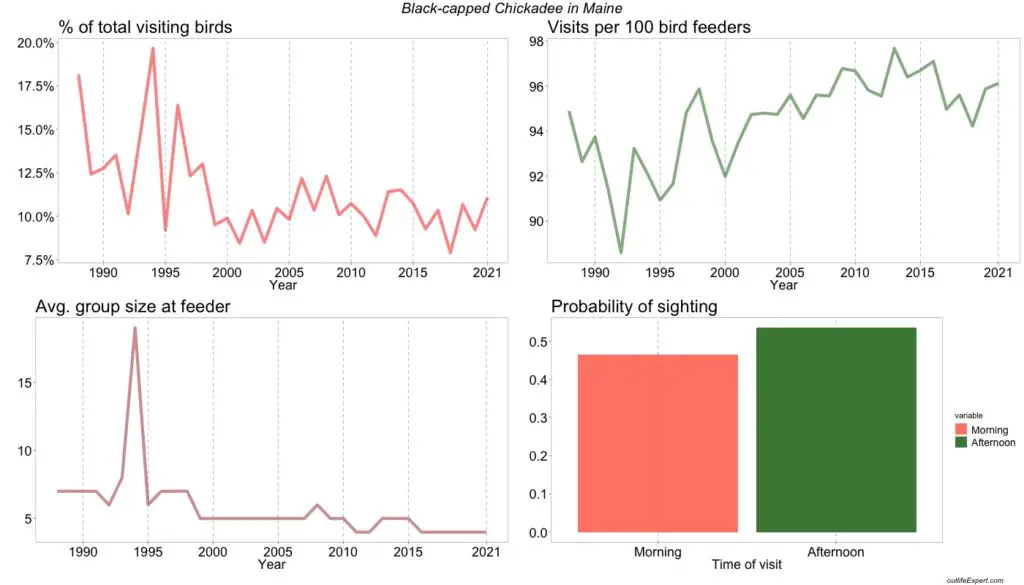
% of total visiting birds: The proportion of the specific bird out of the total number of birds observed bird feeders in this state.
% of total feeders visited: The proportion of feeders (out of all participating feeders in the state each year) where the bird was observed at least once within 2 days.
Avg. group size at feeder: The average number of birds counted simultaneously for each bird feeder observation.
Probability of sighting: The chance of spotting the bird in either morning (before 12 noon) or afternoon (after 12 noon). If both are 0.5 there is an equal chance of spotting the bird in the morning and afternoon.
2. White-breasted Nuthatch (Sitta carolinensis)
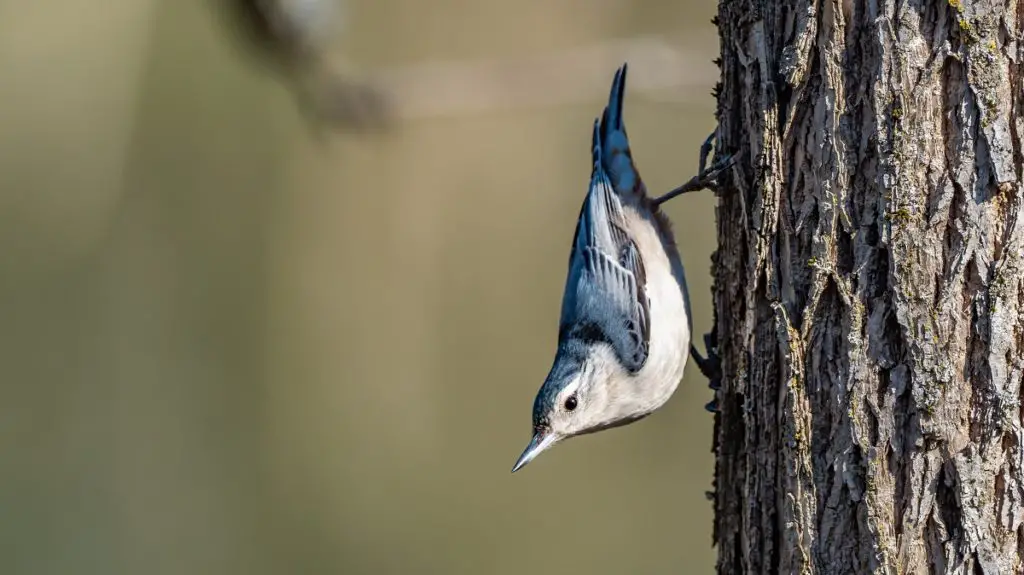
Family: Sittidae
Occurrence: Throughout United States, Canada, and Mexico when forest is present.
Diet in the wild: Insects in the summer, seeds in the winter.
Feeder type preferences:
Feeder food preferences:
- Suet
- Black Oil Sunflower Seeds
- Hulled Sunflower Seeds
- Safflower
- Mealworms
- Crushed peanuts
- Whole peanuts
Endangered: No.
% of Maine feeders visited: 83%
Average flock size seen in Maine : 2
% of total birds at Maine feeders: 3.4%
The white-breasted nuthatch is a common garden bird in western Canada, large parts of Mexico, and most of the US (except for Alaska).
They get their common name from their white breast and their habit to wedge a food item in a crevice and hack them open with their strong bills. They are mostly found in monogamous pairs, but during winter they will sometimes flock with other bird species. They belong to the nuthatch family, Sittidae, and are closely related to wallcreepers, treecreepers, wrens, and gnatcatchers.
There are three other nuthatches in North America: the red-breasted nuthatch, the brown-headed nuthatch, and the pygmy nuthatch.
Identifying the white-breasted nuthatch
White-breasted nuthatches are 5 to 6 inches, have a large head, short tail and wings, and a strong bill and feet. They have blue-grey upperparts with white underparts and face and a black cap extending down to a black bar across the nape of its neck.
They have black and white markings on their wings and tail and a rust-colored undertail.
Females have a slightly narrower nape band, and their coloring is slightly less contrasted than that of the male and their cap is sometimes grey. However, it is often difficult to distinguish males from females in the field.
Juveniles have duller plumage than the adults. They have a wide repertoire of vocalizations, but their most distinctive vocalization is a “Kri-Kri-Kri-Kri” call. There are nine subspecies of white-breasted nuthatch, all visually similar with only slight variations in color, size and bill shape.
None of the other nuthatches in North America have a completely white face. The red-breasted nuthatch has a black eye line, white brow, and a reddish breast. Both the brown-headed nuthatch and the pygmy nuthatch are smaller and have a brown cap instead of black. In the black-capped chickadee, the black cap covers its eyes, and it has a black bib.
Where and when does the white-breasted nuthatch nest?
The white-breasted nuthatch breeds in woodland habitats across North America. Their breeding season is between May and June. The male performs a courtship ritual where he spreads his tail, droops is wings and bows to the female while he sways back and forth.
They use natural cavities or old woodpecker nests in trees for nesting. They form a cup of bark, grasses, twigs, and hair. They will lay five to nine eggs, each less than an inch long, cream colored with brown speckles.
In summer, they eat mostly insects, but in winter, when insects are in short supply, they supplement their diet with seeds and nuts. Their chicks feed almost exclusively on insects.
During autumn and winter, they will stash food from bird feeders in bark crevices for later use.
How to attract the white-breasted nuthatch to your garden
The white-breasted nuthatch will visit birdfeeders for sunflower seeds, peanuts, suet, and mealworms.
In your garden you can plant large trees such as oak, beech and hickory to provide food and potential nesting sites.
Create an insect-friendly garden with lots of indigenous plants and shrubs, a thick mulch layer and dead logs.
Do not use insecticides in your garden. Insecticides not only kill the insects that birds feed on, but could also result in secondary poisoning when birds eat poisoned insects.
Is the white-breasted nuthatch endangered?
The white-breasted nuthatch is listed as least concern, since its population is increasing. However, forest clearance and the removal of dead trees can lead to reduced numbers locally, but may lead to more white-breasted nuthatches to seek towards backyards and birdfeeders in cities.
Their natural predators include birds of prey and snakes. Squirrels compete with nuthatches for tree cavities and will eat their chicks and eggs. Despite these threats, the white-breasted nuthatch is doing quite well in Maine where it has doubled its presence in the last 30 years!
The increased threat of wildfires and spring heat waves due to climate change is causing a northward range shift, which could cause them to go locally extinct in the southern states of their distribution.
From the graph below, you will see that the white-breasted nuthatch is actually more common at bird feeders in Maine. However, this does not necessarily mean that its general population is increasing. It could also mean that the nuthatches seek from the forest towards the cities to obtain food. Either because their habitats are disappearing or simply because backyards are getting more attractive, e.g having more trees or bird feeders, for the nuthatches to enjoy.
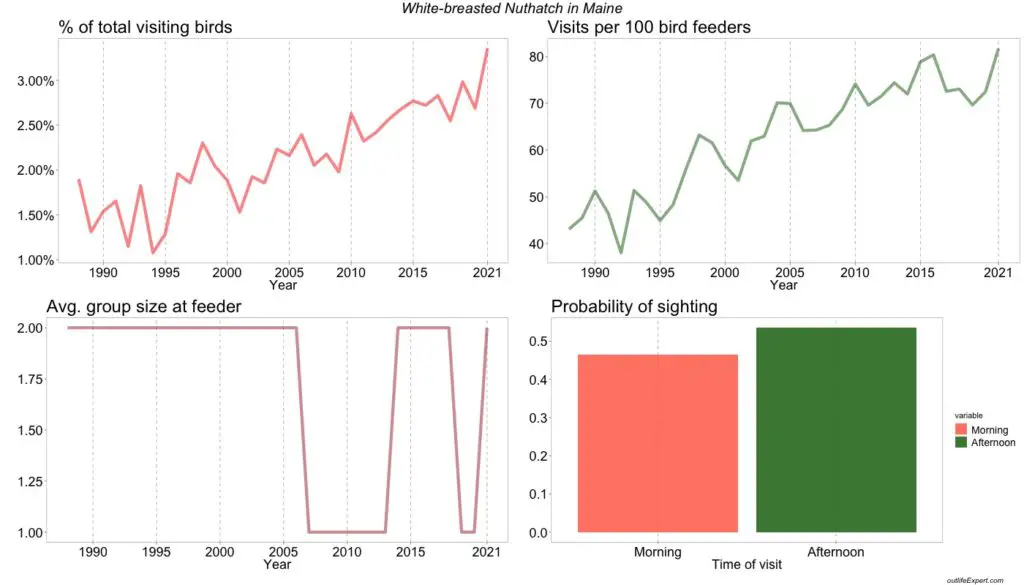
% of total visiting birds: The proportion of the specific bird out of the total number of birds observed bird feeders in this state.
% of total feeders visited: The proportion of feeders (out of all participating feeders in the state each year) where the bird was observed at least once within 2 days.
Avg. group size at feeder: The average number of birds counted simultaneously for each bird feeder observation.
Probability of sighting: The chance of spotting the bird in either morning (before 12 noon) or afternoon (after 12 noon). If both are 0.5 there is an equal chance of spotting the bird in the morning and afternoon.
3. Downy Woodpecker (Picoides pubescens)
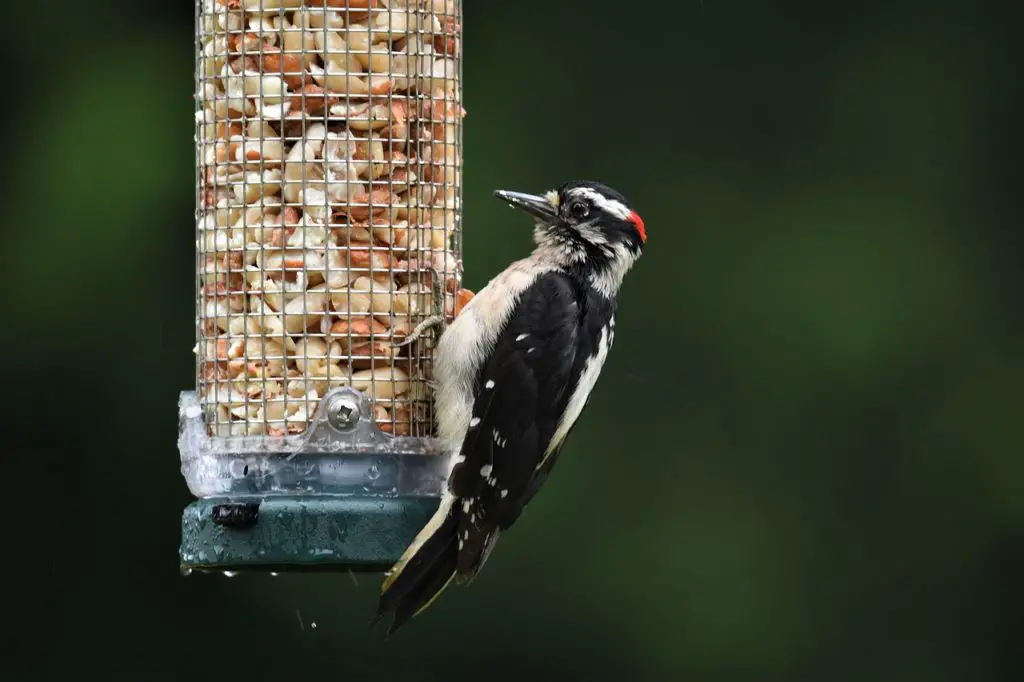
Family: Picidae (woodpeckers)
Origin: Southeastern US.
Diet in the wild: Insects, seeds, berries.
Feeder type preference:
Feeder food preferences:
- Black Oil Sunflower Seeds
- Hulled Sunflower Seeds
- Safflower
- Peanuts
- Crushed peanuts
- Mealworms
- Suet
Endangered: No.
% of Maine feeders visited: 77.7%
Average flock size seen in Maine: 2
% of total birds at Maine feeders: 3.3%
The Downy Woodpecker is the smallest and most recognizable of the North American woodpeckers in the Picidae family. It is native to North America, spanning a huge range from the East to West Coast, as far north as Alaska and into the southern US. It avoids the southwestern US as the climate is too arid and does generally not migrate much in winter Except in the very northern parts.
Identification & Confusion with the Hairy Woodpecker
The Downy Woodpecker is a small woodpecker, weighing around 30g (1 1/16 oz), with a length of 6-7 inches. Downy Woodpeckers have distinctive plumage, with crisp black-and-white markings. They have a black back with a white stripe up the middle, white belly and white outer tail feathers barred. Males have a distinctive red spot at the rear of the crown, while the female’s crown is only black. They have a short, stubby bill they use to excavate wood.
The Downy Woodpecker is often mistaken for the Hairy Woodpecker, as it has similar black and white markings, with a white stripe on the back. The Hairy woodpecker is bigger, has a much longer bill that is nearly half as along as its head, and only have white outer tail feathers.
Unique Behaviours of the Downy Woodpecker
While Downy Woodpeckers are not songbirds, they do have a unique way of making noise with their beaks. They will drum their beaks against wood or metal to create the loud drumming sound we are familiar with. A common misconception is that the drumming is related to the Downy Woodpeckers’ feeding habits or excavation, but they actually make very little noise while foraging or excavating. Downy Woodpeckers drum to find mates and to signal to other woodpeckers that this is their territory.
The Downy Woodpecker will typically stay in the same area after breeding, but will range through different habitats, like suburbs and gardens, looking for food.
Downey woodpeckers participate in some unique behaviours in the winter season. They are the only North American woodpecker that uses the reedbed as a winter habitat. They are also frequently found in mixed-species flocks, alongside chickadees and nuthatches – especially at backyard bird feeders! While Downy Woodpeckers are usually solitary birds, flocking in the winter allows them to spend less time watching for predators, as the flock provides safety in numbers and better opportunities for foraging.
Downy Woodpeckers Nesting and favorite habitats
The Downy Woodpecker can breed in a variety of habitats, including deciduous, mixed deciduous-coniferous forests, suburban woodlands, parks, and areas near rivers. Downy Woodpeckers make their nest in dead trees or branches, which both males and females excavate using their bills, to create a nest hole. They can also nest in man-made objects, such as fenceposts, a nest box mounted on a tree or a pole, or even inside the walls of buildings.
Downy Woodpeckers will often choose deciduous trees or wood infected with fungus, as this softens the wood and makes excavating easier. The entrance holes are round and 1-1.5 inches across, but widens near the bottom to 6-12 inches to fit the eggs and the incubating bird. Excavating the nest takes 1-3 weeks, and they do not add any material to their nest once excavated.
The nesting season runs from May-July, where they may have 1 brood with 3-8 eggs. Both male and female will incubate the egg for about 12 days and fledglings leave the nest after 18-25 days.
What do Downy Woodpeckers eat?
Downy Woodpeckers are foragers, primarily eating insects from the surfaces and crevices of both dead and live trees, including food too small for larger woodpeckers. This includes spiders, ants, caterpillars, beetle larvae that live inside wood, and tree bark. The Downey Woodpecker is a very helpful bird, as it also eats many pests and invasive species, like tent caterpillars, bark beetles, apple borers, and corn earworms. They are also known to eat fruits, seeds, and vegetable matter depending on the seasonal availability.
During winter, the male woodpecker dominates the best foraging spots, like small branches and weed stems, actively keeping females out of these areas. The females are left to forage on tree trunks and larger branches, which are less food dense. A research study demonstrated that when the male Downy Woodpecker is removed, the females move to foraging on the smaller branches.
If you want to attract the Downy Woodpecker, they prefer pick on suet blocks to mimic their natural feeding behaviour. They also like black oil and hulled sunflower seeds, safflower, peanuts, peanut hearts, chunky peanut butter, and mealworms. You can use a suet cage, or feeders like large or small hopper and platform feeders.
You can also find the woodpecker drinking out of oriole and hummingbird feeders, but at feeders the Downy Woodpecker will give way to its larger family member, and lookalike, the Hairy Woodpecker.
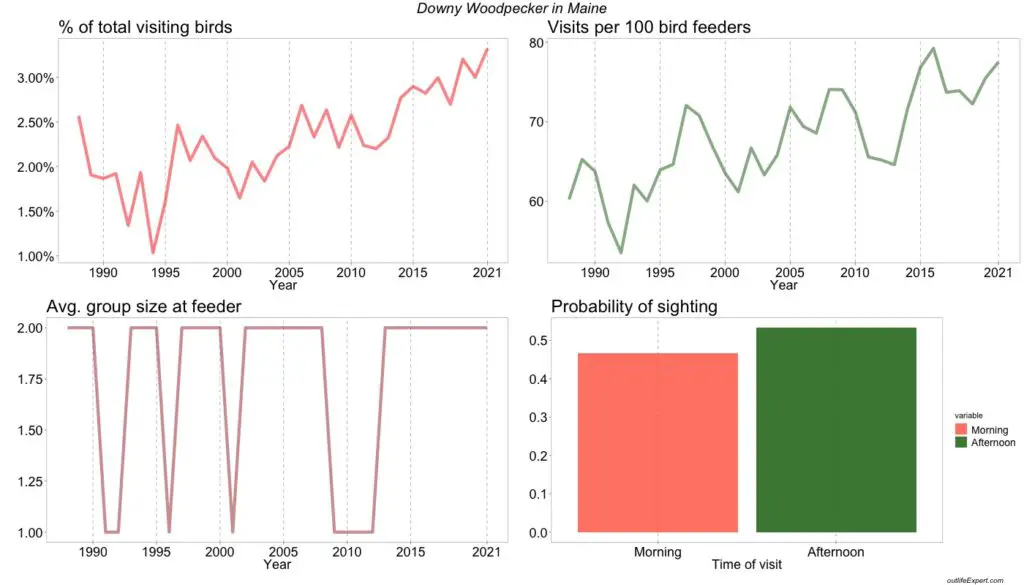
% of total visiting birds: The proportion of the specific bird out of the total number of birds observed bird feeders in this state.
% of total feeders visited: The proportion of feeders (out of all participating feeders in the state each year) where the bird was observed at least once within 2 days.
Avg. group size at feeder: The average number of birds counted simultaneously for each bird feeder observation.
Probability of sighting: The chance of spotting the bird in either morning (before 12 noon) or afternoon (after 12 noon). If both are 0.5 there is an equal chance of spotting the bird in the morning and afternoon.
4. Tufted Titmouse (Baeolophus bicolor)
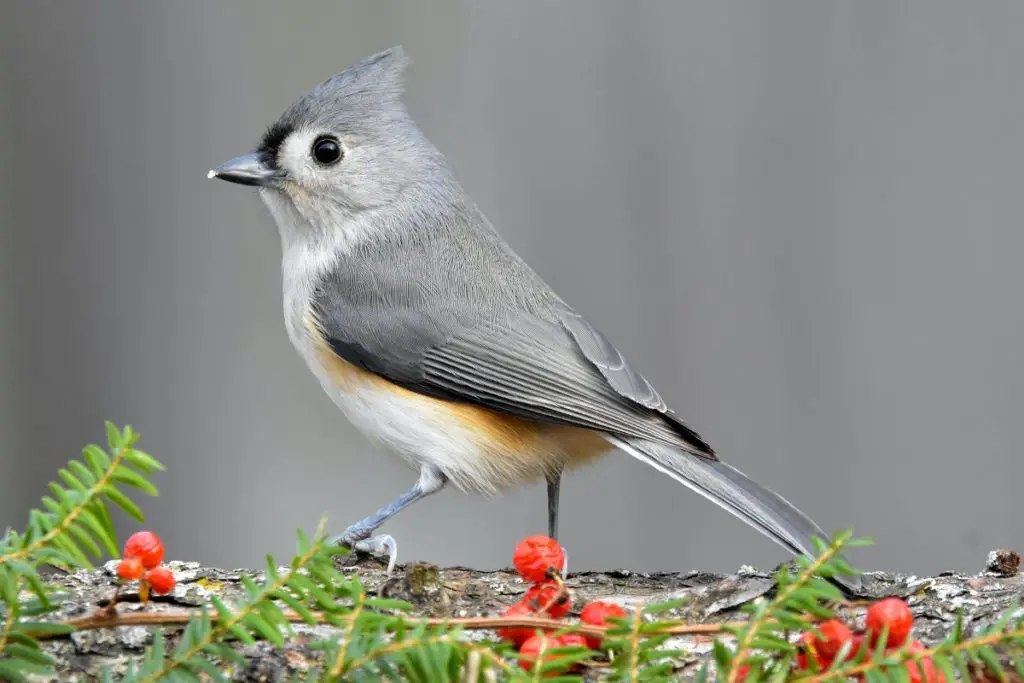
Family: Paridae
Occurrence: Southeastern US.
Natural diet: Insects (mostly summer), fruit, seeds, and nuts in winter.
Feeder type preferences:
Feeder food preferences:
- Black Oil Sunflower Seeds
- Hulled Sunflower Seeds
- Safflower
- Mealworms
- Crushed peanuts
- Whole peanuts
- Suet
Endangered: No.
% of Maine feeders visited: 77%
Average flock size seen in Maine : 2
% of total birds at Maine feeders: 5%
The tufted titmouse is a small, grey bird of roughly six inches. They are often found in pairs or small flocks, sometimes with other bird species. They can be seen hopping and flitting about around the bird feeder. They will pick a seed from the feeder and fly to a nearby perch to eat it. Other names they are known by is the eastern tufted titmouse, the northern titmouse, or the crested titmouse. Their Latin name captures their two most distinctive features. Baelophus means “small crested” and bicolor means “two-toned”.
The tufted titmouse is a common garden bird in the Eastern United States, and the southmost parts of Ontario, Canada. Originally from the deciduous forests of the Ohio and Mississippi River basins, these birds do well in suburban areas like parks and gardens. Their distribution has expanded over the last few years, supposedly due to warming winters and bird feeders in urban areas.
They belong to the family Paridae, which contains titmice, chickadees and tits. There are four other titmouse species: the black-crested titmouse, the oak titmouse, the juniper titmouse, and the bridled titmouse. The black-crested titmouse (found in Texas and Mexico) used to be considered a subspecies of the tufted titmouse and they can interbreed. However, they are now considered two separate species.
Identifying the tufted titmouse
The tufted titmouse is mostly grey with white undersides. They have a white face with a black forehead, a distinctive grey crest, and an orange streak across their flanks. Their song sounds like a whistled “peter-peter-peter”.
The closely related black-crested titmouse, in contrast, has a white forehead, a black crest, and a “peew, peew, peew, peew” song. Hybrids between tufted and black-crested titmice can cause confusion in certain parts of Texas and southwestern Oklahoma. Their forehead can be light orange to dark brown and their crest can be grey or black.
Juvenile tufted titmice have a grey forehead, instead of black, and resemble their all-grey cousins the oak and juniper titmouse. However, their distributions do not overlap. The oak titmouse only occurs along the West Coast of the United States. And the Juniper titmouse occurs in the inland areas of the Southwest.
Biology of the tufted titmouse
Between March and May, the tufted titmouse will use natural cavities, old woodpecker nests, or man-made nest boxes to nest in. They will form a ring of twigs and grasses and line them with soft material such as animal fur. Inside the nest, they will lay five to seven cream-colored eggs with brown spots. Offspring often stay with their parents through the winter and occasionally into the next breeding season to assist in raising the next brood.
A tufted timouse’s diet consists of small fruits, seeds and insects. Similar to other parid birds, they hoard food in fall and winter. During these seasons, they will collect food from bird feeders and store them in small holes and crevices.
How to attract the tufted titmouse to your garden
Sunflower seeds are a firm favorite with tufted titmouse. Other food they like include suet, peanuts, berries and mealworms. In your garden, you can plant oak trees, natural berries and sunflowers. A water bath could provide essential drinking water during the winter months when many natural water sources are frozen. During the breeding season, you can put up nest boxes in your garden.
Conservation status and threats of the Tufted Titmouse
Tufted titmice are listed as least concern and their population is steadily increasing. However, they face several threats in urban areas, including predation by cats and collision with glass. If you want to protect the nest of the tufted titmouse, predator guards underneath their nest boxes can protect vulnerable eggs and hatchlings and window stickers on your windows or net curtains can prevent collisions of the tufted titmouse with your house.
In Maine, however, the Tufted Titmouse population is rapidly increasing being sighted more than four times more than 30 years ago!
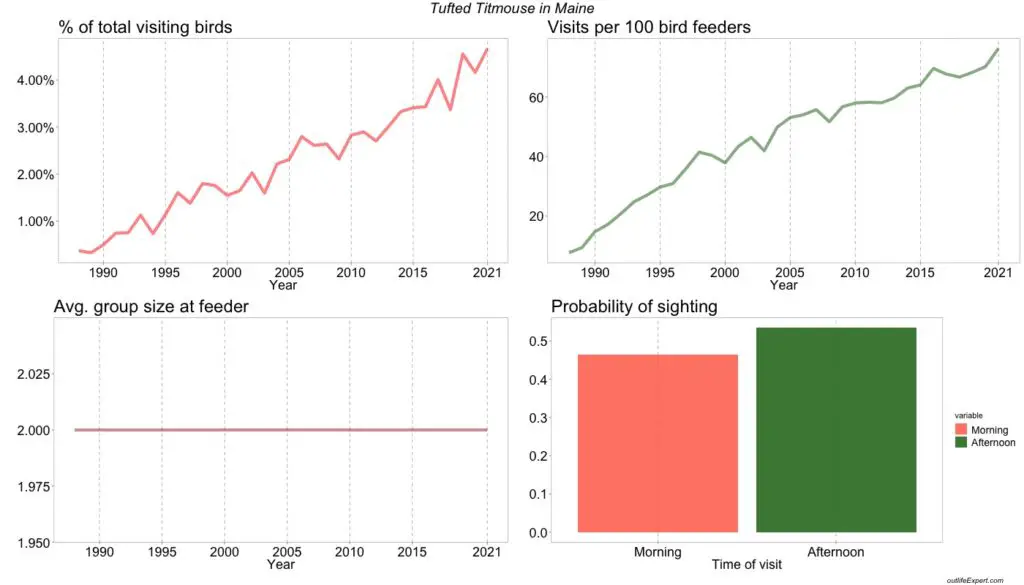
% of total visiting birds: The proportion of the specific bird out of the total number of birds observed bird feeders in this state.
% of total feeders visited: The proportion of feeders (out of all participating feeders in the state each year) where the bird was observed at least once within 2 days.
Avg. group size at feeder: The average number of birds counted simultaneously for each bird feeder observation.
Probability of sighting: The chance of spotting the bird in either morning (before 12 noon) or afternoon (after 12 noon). If both are 0.5 there is an equal chance of spotting the bird in the morning and afternoon.
5. Blue Jay (Cyanocitta cristata)
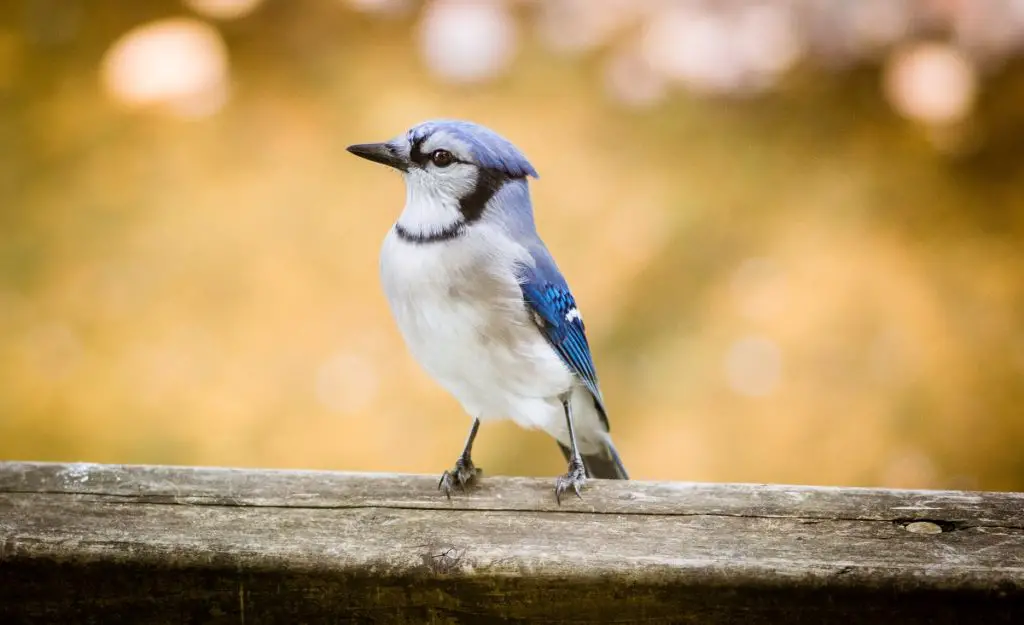
Family: Corvidae
Occurrence: Eastern United States. Southern Canada.
Diet in the wild: Acorns, seeds, berries, insects, small animals.
Feeder type preferences:
Feeder food preferences:
- Suet
- Black Oil Sunflower Seeds
- Hulled Sunflower Seeds
- Safflower
- Mealworms
- Fruit
- Whole peanuts
- Crushed peanuts
- Nyjer seeds
- Milo
- Millet
Endangered: No.
% of Maine feeders visited: 75%
Average flock size seen in Maine: 5
% of total birds at Maine feeders: 10%
The blue jay is a conspicuous garden bird throughout southern Canada, eastern and central United States. Cyanocitta, the first part of its Latin name, is derived from the Greek words “kyaneos”, which means blue, and “kitta”, which means chattering bird. Cristata, the last part of its name in Latin, is derived from the Latin word for “crested”.
In the northern regions, some will migrate south for the winter, depending on weather conditions and food abundance.
Blue jays belong to the Corvidae (crow) family and are related to crows, magpies, and nutcrackers. There are four subspecies of blue jays: the northern blue jay, the coastal blue jay, the Florida blue jay, and the interior blue jay. Their closest relative is Steller’s jay, and hybrids have been reported where their distributions overlap.
They are the official mascot of the Toronto Blue Jays baseball team, John Hopkins University (Maryland), Elmhurst University (Illinois), and Creighton University (Nebraska). They are the provincial bird of Prince Edward Island in Canada. They also feature in Cartoon Network’s Regular Show as the cartoon character Mordecai.
Identifying the blue jay
The blue jay is 9 to 12 inches, blue with a white face and underparts. They have a characteristic blue crest, which they raise when agitated. Their black collar extents up from their neck to frame the back of their crest.
Their wings and tail have black and white barring. The black markings on their face and neck vary between individuals. They have several calls and sounds, including a loud “jay! jay!”. They can mimic the calls of raptors to scare away other birds from food sources.
Of the four subspecies, the northern blue jay is the largest with the palest blue color. They occur in Canada and the northern United States.
The coastal blue jay is vivid blue and is found along the coast from North Carolina to Texas, except for south Florida, where the Florida blue jay is found. The Florida blue jay is smaller and paler than the coastal blue jay. The interior blue jay is found in inland USA and is dark blue with a contrasting white underside.
The closely related Steller’s jay has a black crest and head, their underparts are blue instead of white, and they lack the barring on their wings.
Other birds that can be confused with the blue jay include the Florida scrub-jay, Woodhouse’s scrub-jay, and the California scrub-jay.
However, these birds have no crest, no barring on their wings, no collar around their neck, and grey faces, instead of white.
How to tell the difference between the male and female blue jays?
Biology
Their natural habitat is deciduous and coniferous forests, but they are well adapted to suburban areas. They will eat almost anything, including seeds, nuts, fruits, insects, and occasionally the eggs and chicks of other birds, small rodents, and frogs.
They are aggressively territorial towards other birds, predators, and humans. Blue jays sometimes get mobbed by other birds because blue jays are known to raid nests. On the other hand, birds in the same area can benefit from the loud alarm call of the blue jays and their ability to chase away predators.
Their breeding season is from March to May. Their nest is an open cup between tree branches. Sometimes they steal the nests of other songbirds, such as the American robin. They will lay two to seven blueish-brown eggs with brown spots.
How to attract the blue jay to your garden
In your birdfeeder, you can place peanuts, sunflowers, cracked corn, millet, suet, and mealworms for the blue jay. Large trees like oak and beech can provide shelter, food, and potential nesting sites. Crabapple, red mulberry, and wild cherry will attract blue jays with their fruit. You can provide a large bird bath for them to wash in and drink from in your garden.
Conservation status and threats
The blue jay is listed as least concern and their numbers are stable. Recently, their population has been declining along the Atlantic coast, and increasing in the northern parts of its range in southern Canada. Climate change might lead to range retractions in its northwestern distribution. Their main threats are spring heat waves endangering their chicks and urbanization destroying suitable habitat.
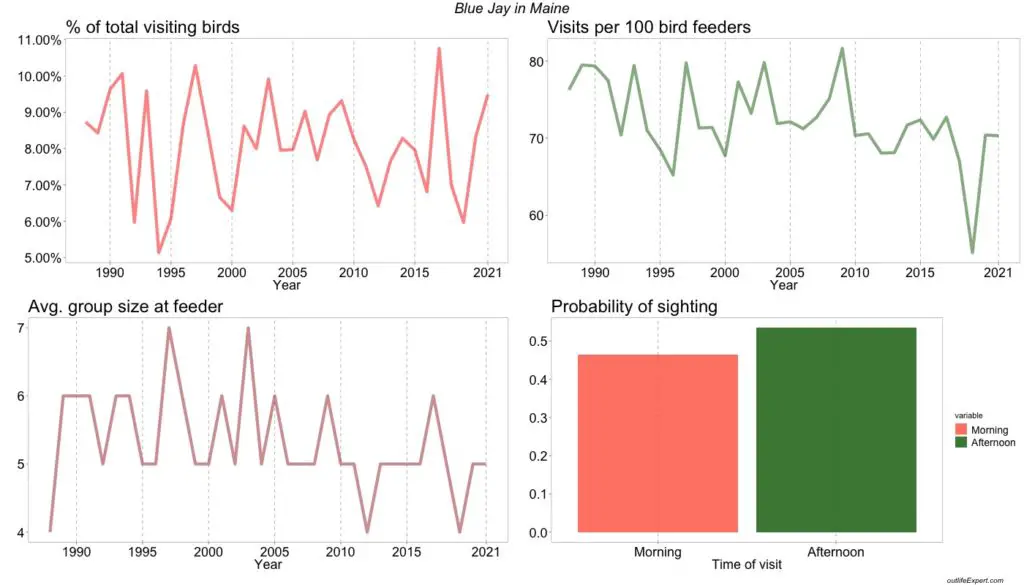
% of total visiting birds: The proportion of the specific bird out of the total number of birds observed bird feeders in this state.
% of total feeders visited: The proportion of feeders (out of all participating feeders in the state each year) where the bird was observed at least once within 2 days.
Avg. group size at feeder: The average number of birds counted simultaneously for each bird feeder observation.
Probability of sighting: The chance of spotting the bird in either morning (before 12 noon) or afternoon (after 12 noon). If both are 0.5 there is an equal chance of spotting the bird in the morning and afternoon.
6. Mourning Dove (Zenaida macroura)
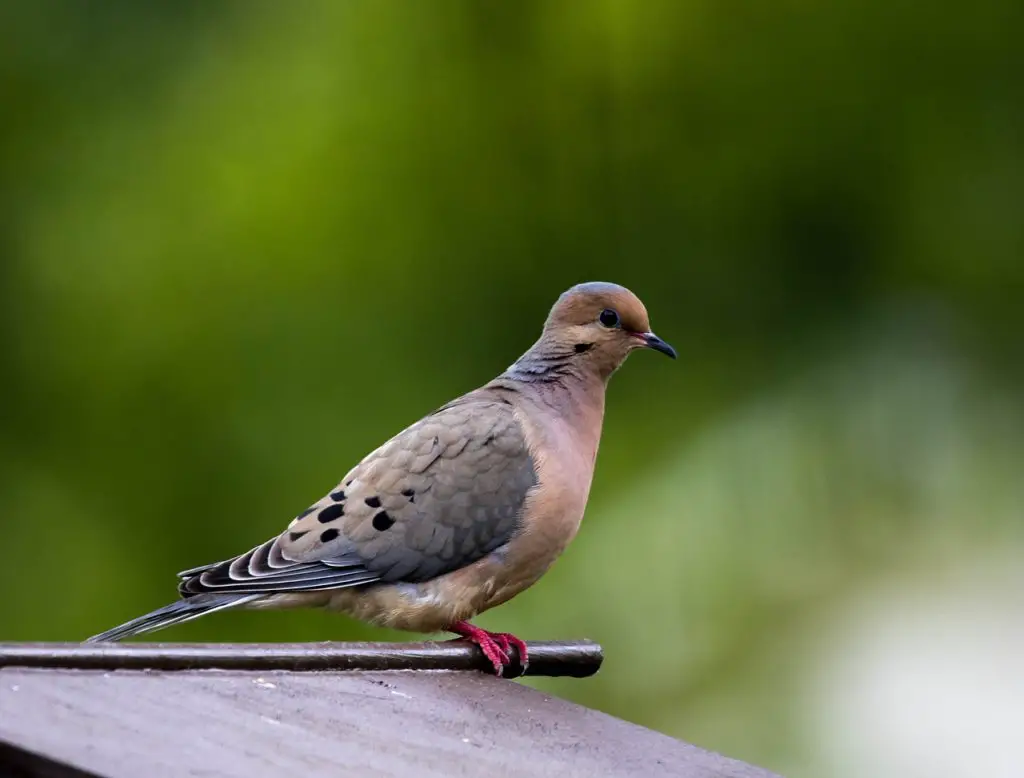
Mourning Dove summary:
Family: Columbidae
Occurrence: Widely across the United States and Canada. Native to Bermuda.
Diet in the wild: Seeds.
Feeder type preferences:
Feeder food preferences:
- Black Oil Sunflower Seeds
- Hulled Sunflower Seeds
- Safflower
- Cracked Corn
- Crushed peanuts
- Millet
- Oats
- Milo
- Nyjer seeds
Endangered: No.
% of Maine feeders visited: 74.2%
Average flock size seen in Maine : 6%
% of total birds at Maine feeders: 12.4%
The mourning dove is one of the most abundant land birds in North America, with an estimated population of 350 million. These birds are known and named for their mournful calls, sometimes confused with owls, and a sharp whistling sound made by their wings when taking off.
Identification of the mourning dove
It is a medium sized dove, (similar to a robin in size) has a long, pointed tail, with a plump body, tiny head, and distinctive dark spots on its wings. It is brownish with a tan head, gray wings with black spots, a black bill, pink feet, and a black dot on the side of the face.
Male doves can be distinguished from females, by a purple iridescence on the neck. The mourning dove may get confused with the Eurasian Collared-dove or the white-winged dove. The Mourning Dove species consists of four sub-specifies, two of which can be found in North America: Z. m. carolinensis, found east of the Mississippi River, and Z. m. marginella in the west.
Habitat and migration of the mourning dove
The Mourning dove has a huge range across North America, meaning there are a variety of breeding and migration patterns depending on where they originate.
Mourning doves who live in the northern end of the range (northern USA, southern Canada) migrate as far south as Mexico. While birds in the central and southern US, might migrate only a few hundred km or not migrate at all.
Mourning doves prefer open spaces, like residential suburbs, rural areas, woodland edges, and fields, but avoids thick forested areas. Most people might recognize the mourning dove from perching on telephone poles and eating from their bird feeder.
Nesting & Breeding of the mourning dove
Mourning doves typically nest from February through October and can have anywhere from 1-6 broods (depending on source) with 2 eggs. These birds mate for life, and work together to build the nest, hatch the eggs, and feed their young.
Over a span of 2-4 days, the male will bring the female materials, which she then weaves into a nest approximately 8 inches across. Males sit on the nest during the day, while the females take the night shift. Eggs incubate for 14 days and nestlings stay for 12-15 days.
Mourning doves will build their nests in a variety of locations – they are not picky and are mostly unbothered by humans.
Typical locations include branches of evergreen, vines, cottonwood, orchard tress and mesquite. In the west, nesting on the ground is common nests can also be found in gutters, abandoned equipment, hanging planters, and eaves.
Nests are made from twigs, pine needles, and grass stems and are described as flimsy in construction. They are unlined and don’t have much in the way of insulation for the young. It is quite common for mourning doves to reuse their own nests, or reuse the rests of other species of birds.
Diet of the mourning dove and how to attract it
Mourning Doves are primarily foragers, finding seeds on the ground to eat and they may eat up to 20% of their body weight per day.
Seeds make up 99% of its diet, which can include cultivated grains, peanuts, wild grasses, weeds, herbs, berries and even occasionally snails! The mourning dove typically gets its food quickly, stores it in their crop, and digests it later while roosting.
To attract the mourning dove to your own backyard, we recommend scattering seeds on the ground on platform feeders or in a large hopper feeder.
They prefer black and hulled sunflower seeds, safflower, nyjer, cracked corn, peanut hearts, millet, oats and milo. Since this bird spends so much time on the ground, try and keep prowling animals, like cats, inside.
Encourage nest building by planting dense shrubs or evergreen trees, or even put up a nesting cone in advance of the breeding season.
The mourning dove is a popular game bird
These birds are the most hunted game bird in North America, with around 20 million shot each year. The hunting season varies between regions, but can span from September-January. It is one of the only birds whose hunting season overlaps with its nesting season.
Despite the high volume of hunting, there isn’t a high level of concern for conservation according to the Continental Concern Score. There are some differing opinions around the degree to which hunting is impacting this species.
Game managers and conservationists monitor the species population numbers to set hunting limits for the mourning dove. However, some sources say that the breeding population cannot keep up their numbers with the pressure from hunting, especially since nesting doves can be hunted.
A unique side effect of hunting is the lead poisoning of mourning doves in hunting heavy areas. Due to being a ground forager, these birds consume spent lead shot, leading to 1/20 doves eating lead.
Despite hunting of the Mourning Dove, it is still very abundant in American backyards and are frequent visitors of bird feeders.
In Maine, although visiting in fewer numbers per visit, the total number of Mourning Doves are stable throughout Maine backyards.
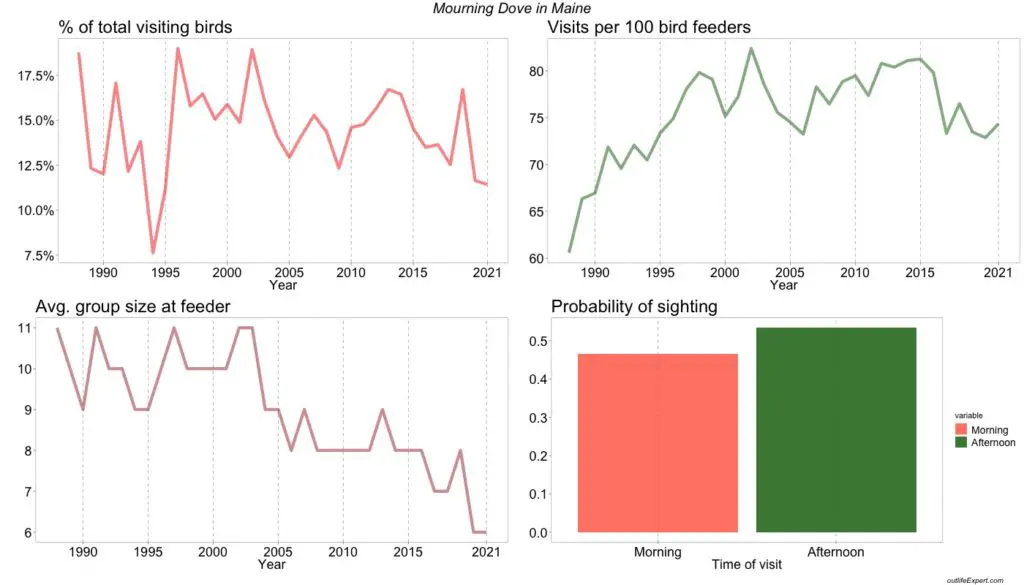
% of total visiting birds: The proportion of the specific bird out of the total number of birds observed bird feeders in this state.
% of total feeders visited: The proportion of feeders (out of all participating feeders in the state each year) where the bird was observed at least once within 2 days.
Avg. group size at feeder: The average number of birds counted simultaneously for each bird feeder observation.
Probability of sighting: The chance of spotting the bird in either morning (before 12 noon) or afternoon (after 12 noon). If both are 0.5 there is an equal chance of spotting the bird in the morning and afternoon.
7. Hairy Woodpecker (Leuconotopicus villosus)
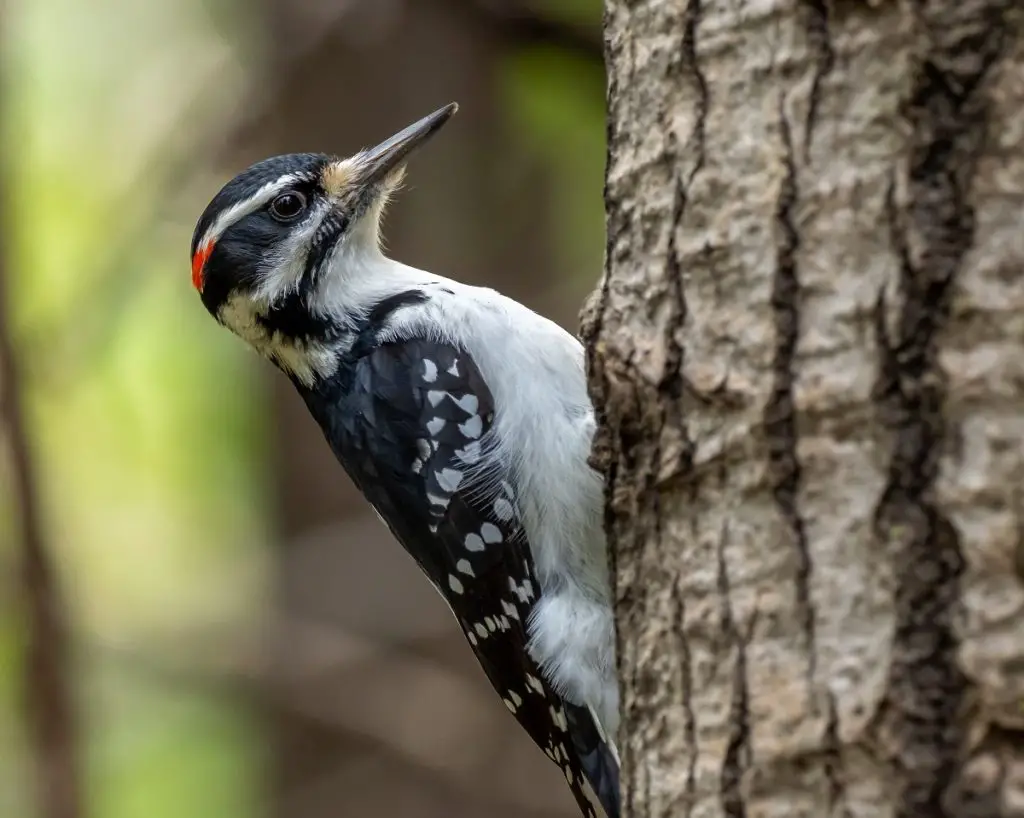
Family: Picidae (Woodpeckers)
Occurrence: Throughout North America, Canada (mostly Western parts) and Mexico.
Natural diet: Insects, nuts and seeds.
Feeder type preferences:
Feeder food preferences:
- Black Oil Sunflower Seeds
- Hulled Sunflower Seeds
- Safflower
- Mealworms
- Crushed peanuts
- Whole peanuts
- Suet
Endangered: No.
% of Maine feeders visited: 67.7%
Average flock size seen in Maine: 1
% of total birds at Maine feeders: 2.7%
Fifty-seven species of woodpecker, divided into fourteen genera, occur in North America. Most woodpeckers in North America live among the tree trunks of larger forest, although some species, such as the Gila woodpecker, live in the desert and use cacti as breeding grounds.
The Hairy Woodpecker can be found in most places in North America and Canada. The Hairy Woodpecker was first described and illustrated in a hand-colored plate by the British naturalist Mark Catesby in the 1730s.
The Hairy Woodpecker is one of three closely related species of woodpeckers that visit birdfeeders most often and they all share the same characteristics and mannerisms. Hairy Woodpeckers resemble the downy woodpecker but are smaller and have a shorter bill.
Unlike the spotted woodpecker, they are more common, shy, and restricted to areas with large trees. They have large fluffy black spots on their shoulders, have a straight posture, hang on tree trunks, and never feed on weed stalks. The Hairy Woodpecker gets its strange name from the thin white feathers than run down its back, lying on top of the black feathers.
How and where to spot the Hairy Woodpecker
This woodpecker is 9- 11 inches (23-28 cm) in length with a wingspan of 15-16 inches (38-41 cm). There are slight differences in this species in the different regions and generally the birds are larger in the north than in the south.
The Hairy Woodpecker can live up to 16 years.
The male bird in the interior west is black and white in color with a black stripe along its face, a long thin bill and distinctive red flash towards the back of its head. The female has the same facial stripes, nearly black wings but no red flash. Woodpeckers of both sexes from the Rockies have broader facial stripes and the male has white spotting on its wings. Birds from the Pacific northwest are brown and black in color – like a cup of coffee. Interestingly, the Hairy Woodpecker has very long stiff tail feathers which helps them balance against tree trunks.
The Hairy Woodpecker lives in woodlands comprising of both coniferous and deciduous trees and actual prefers mature woodland areas but may visit densely wooded backyards and parks. You are most likely to hear the loud pecking and drumming of the woodpecker first and then spot it at work on a tree truck or branch foraging for its favorite insect – bark beetles.
The Hairy Woodpecker is a noisy bird! Its pecking is low in tone but loud and it’s drumming even louder! It is often mistaken for a Downy Woodpecker as the two do look similar, the Hairy Woodpecker is larger than the Downy Woodpecker and has a much longer bill. The noises it makes are lower pitched too.
Habitat and mating of the Hairy Woodpecker
The Hairy Woodpecker is monogamous and pairs for life. They love to nest in a cavity they have created in the trunk of a dead tree. They have one brood each year in May, which usually comprises of four eggs. Both the male and female take turns to feed their young with soft insects. Whilst they are incubating the eggs and raising their young, the woodpeckers are remarkably silent.
What does the Hairy Woodpecker eat and how do I attract it?
The Hairy Woodpecker has a long chisel-like bill for probing tree bark for larvae and insects. The preferred foods of Hairy Woodpeckers include:
- insects
- larvae
- beetles
- ants
- caterpillars
- berries
- nuts
- seeds
Hairy Woodpeckers can be found in most North American suburban areas, visiting parks, backyard bird feeders and cemeteries with larger trees.
If you want to attract them to your bird feeder, make sure you have suet and sunflower seeds!
Although still common to see and not currently threatened by extinctions, the future of the Hairy Woodpecker may be compromised if more of its natural habitats are being lost to forest clearing and increase in forest fires.
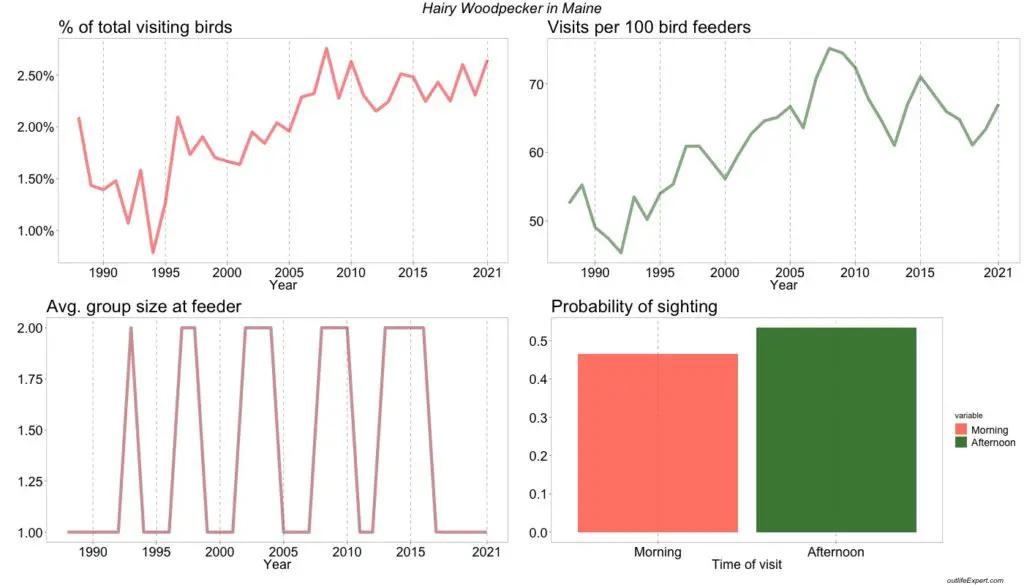
% of total visiting birds: The proportion of the specific bird out of the total number of birds observed bird feeders in this state.
% of total feeders visited: The proportion of feeders (out of all participating feeders in the state each year) where the bird was observed at least once within 2 days.
Avg. group size at feeder: The average number of birds counted simultaneously for each bird feeder observation.
Probability of sighting: The chance of spotting the bird in either morning (before 12 noon) or afternoon (after 12 noon). If both are 0.5 there is an equal chance of spotting the bird in the morning and afternoon.
8. Red-Breasted Nuthatch (Sitta canadensis)
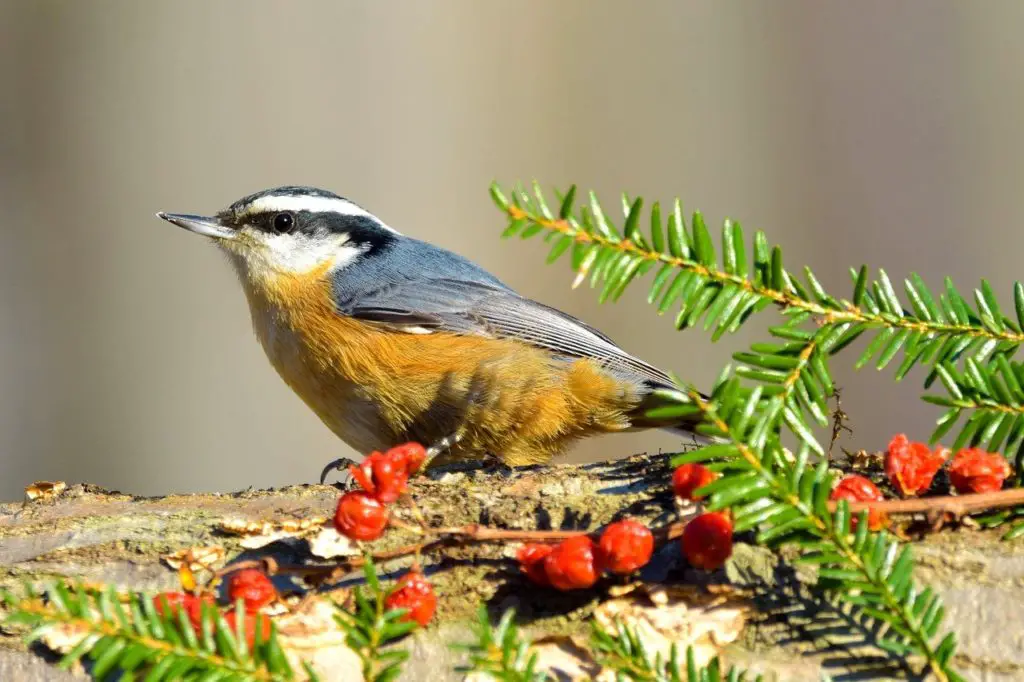
Family: Sittidae
Occurrence: Throughout United States, and southern/mid parts Canada.
Diet in the wild: Insects in the summer, seeds in the winter.
Feeder type preferences:
Feeder food preferences:
- Suet
- Black Oil Sunflower Seeds
- Hulled Sunflower Seeds
- Mealworms
- Crushed peanuts
- Whole peanuts
Endangered: No.
% of Maine feeders visited: 65%
Average flock size seen in Maine: 2
% of total birds at Maine feeders: 2.8%
The Red-Breasted Nuthatch is a small songbird that is full of energy, very curious and sometimes aggressive towards other birds- particularly in the mating season. The Nuthatches got their name due to their red colored chest and because of the way they fasten nuts into small cracks and peg them open with their bill.
The Red-Breasted Nuthatch is mostly observed at bird feeders in the northern parts of the US and least observations have been made in the South. The populations have fluctuated over time, but mostly for the central and southern parts, and may be due to the increased migration of the Red-Breasted Nuthatch towards the south in years of sparse food supply in the north.
Where does the Red-Breasted Nuthatch come from?
The Red-Breasted Nuthatch can be found in the conifer forests that stretch across North America and most of Canada. It is native to the northern parts of the US but can be seen throughout the country, especially in the mountains of the west, the rolling hills of the eastern states, the Appalachians and the immense forests of Alaska.
How and where to spot the Red-Breasted Nuthatch
These birds measure just 11 cm (4.3 inches) in height with a wingspan of 22 cm (8.6 inches) but they have distinctive markings. They have blue/grey wings and a cinnamon-colored underside, with a white face and throat and a black cap. What is distinctive is the black stripe that passes through their eyes and their long-pointed bill which they use for digging food our of wood and carving holes in the tree trunks where they can build their nests. Their tails are relatively short the female birds are not so brightly colored and their eye stripe is brown rather than black. Both sexes have plumage, but females and young have a duller head and a lighter underside.
The Red-Breasted Nuthatch can be confused with a Black-capped Chickadee, but a second glance will show that they have a longer tail, a smaller bill, and are larger than nuthatches. If you watch them for a while, another tell-tale sign is that they don’t climb up and down tree trunks like nuthatches do looking for insects to eat.
The most likely place you will spot them is in a conifer forest as they are fond of spruce and fir trees. You can spot them in small flocks with chickadees, kinglets and woodpeckers and they can often be seen on tree trunks and branches as they forage for food. The Red-Breasted Nuthatch is monogamous and also remains in its main territory for most of the year, which they guard jealously.
This species is prey to larger birds including hawks, Merlin and spotted owls as well as squirrels and weasels.
The Red-Breasted Nuthatch has a very distinctive call which is a single note repeated several times that has been likened to a tin trumpet!
Habitat and mating of the Red-Breasted Nuthatch
The Red-Breasted Nuthatch loves pine trees and when it comes to nesting time, these birds use their sharp bills to carve out a hollow in the trunk of a pine tree. They build their nest in the hollow by lining it with grass and they then add a layer of feathers for comfort. It is not unusual for the Red-Breasted Nuthatch to steal nesting material from other birds’ nests.
The male also smears pine resin around the entrance to the nest for protection from predators and the female smears pine resin in the nest itself. The birds have just one brood each year, usually in May-July when the female usually lays 5-7 eggs. At this time, the male will be particularly aggressive and chase other birds away from his nest.
The Nuthatches that live in more northern areas often migrate south in September/October if they feel there are not adequate supplies of cone seeds in the forest. If they do stay put and the temperature drops significantly, they will roost communally in a hole in an evergreen tree to try and keep warm. There can be as many as 100 birds in the roost.
What does the Red-Breasted Nuthatch eat and how do I attract it?
The nuthatch uses its long sharp bill to probe in bark to find beetle grubs and insect larvae. In the winter months when these foods are scarce, the Nuthatch eats seeds. Nuthatches are a bit shy at backyard bird feeders, but will gladly visit if there is suet, sunflower seeds, or peanuts on the menu.
Red-Breasted Nuthatches are not considered endangered at all and in the last five years their general numbers throughout the US have been steadily increasing.
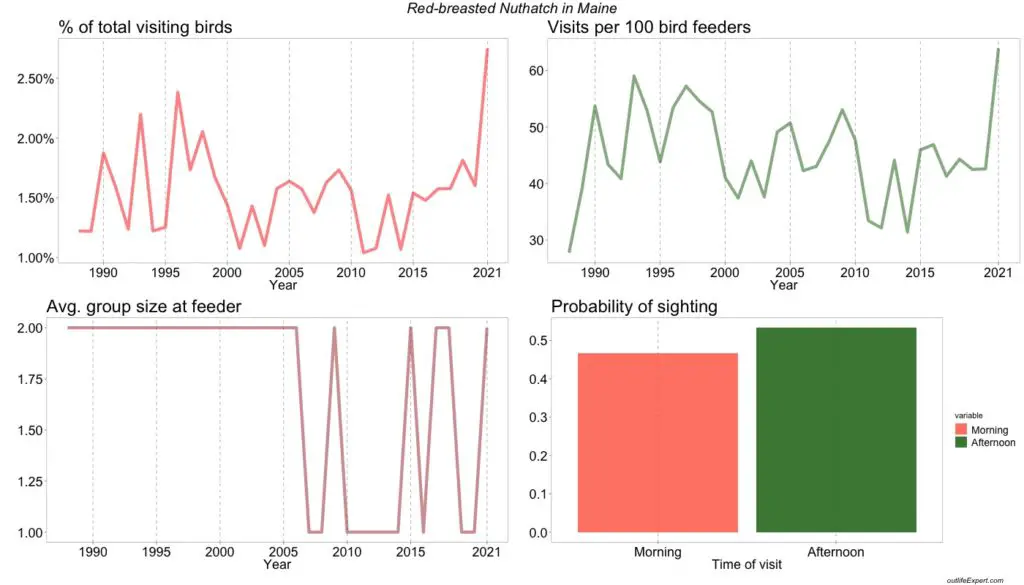
% of total visiting birds: The proportion of the specific bird out of the total number of birds observed bird feeders in this state.
% of total feeders visited: The proportion of feeders (out of all participating feeders in the state each year) where the bird was observed at least once within 2 days.
Avg. group size at feeder: The average number of birds counted simultaneously for each bird feeder observation.
Probability of sighting: The chance of spotting the bird in either morning (before 12 noon) or afternoon (after 12 noon). If both are 0.5 there is an equal chance of spotting the bird in the morning and afternoon.
9. Northern Cardinal (Cardinalis cardinalis)
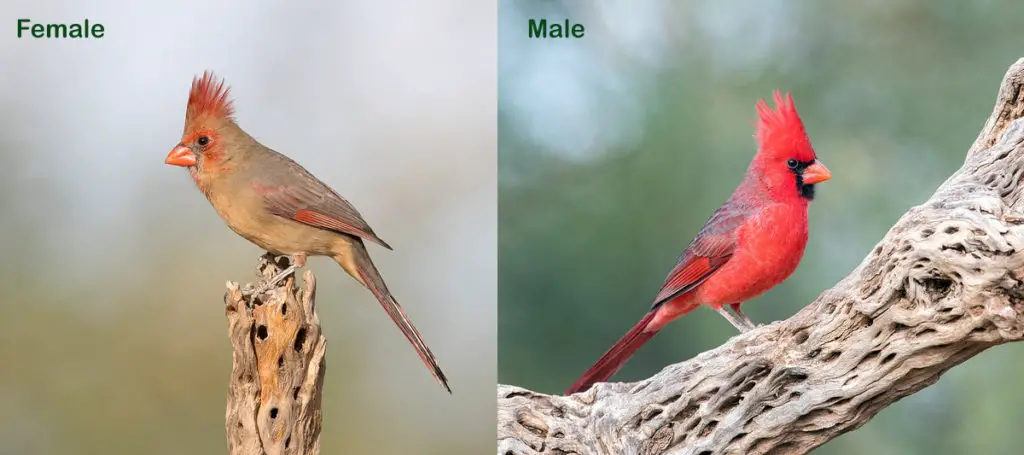
Family: Cardinalids
Origin: Southeastern US.
Diet in the wild: Insects, seeds, berries, flowers.
Feeder type preferences:
- Ground Feeder
- Large Tube feeder
- Large Hopper
- Platform feeder
Feeder food preferences:
- Black Oil Sunflower Seeds
- Hulled Sunflower Seeds
- Safflower
- Crushed peanuts
- Millet
- Milo
- Cracked Corn
Endangered: No.
% of Maine feeders visited: 59%
Average flock size seen in Maine : 2
% of total birds at Maine feeders: 3.3%
The Northern Cardinal is a common backyard bird seen throughout the United States, where it may also go under the nicknames of red cardinal, common cardinal, redbird, or simply cardinal. Its many names exemplify its representation of the wider cardinal family, Cardinalidae, which includes several other common birds such as the Dickcissel, some grosbeaks, and the buntings.
From where does the Northern Cardinal originate?
It is native to the Southeastern United States, where it is the official state bird of several states: West Virginia, Indiana, Virginia, Ohio, Illinois, Kentucky, and North Carolina. Furthermore, several institutions, including sports teams such as the St. Louis Cardinals and Arizona Cardinals use it as their mascot.
At the national level, the trend is stable over time and the majority of observations of the Northern Cardinal have been made in the Eastern parts of the country.
How and where to spot the Northern Cardinal
Many Cardinalids are strongly colored, making them easy to spot at the bird feeder. Especially the brightly blue Indigo Bunting and the multicolored Painted Bunting are amazing examples of this colorful family.
The male Northern Cardinal is easy to recognize as it is the only bright red bird seen all year round in the Northern parts of the US. The female is predominantly brown and less brightly colored which may lead to confusion with other Cardinalids, for example, its Pyrrhuloxia, Summer Tanager, or Hepatic Tanager cousins. These cardinals, however, are more widespread in the southwestern states and northern Mexico where the Northern Cardinal is less common.
All Cardinalids are highly vocal, and the Northern Cardinal comes across as exceptionally noisy, boasting a loud metallic voice with which it sounds the characteristic “tik-tik” call or a softer slurred whistle.
Whereas some cardinals are brightly colored throughout their entire body, the Pyrrhuloxia, which has a parrot-like bill and is considered the Southwest’s equivalent of the Northern Cardinal, is gray with crimson red patches throughout its body.
Habitat and mating of the Northern Cardinal
It prefers relatively moist habitats, such as deciduous woodlands, scrublands, desert washes, and backyards. Their breeding season is March-August where the male is particularly aggressive and repels any intruder. He is so aggressive that he will occasionally confront his own reflection in windows and various shiny surfaces.
The nest of the Northern Cardinal is somewhat flimsy with thin barks, grasses, and leaves. However, it is also “single-use” as they do not usually use the nest again the coming year. The female lays 2-4 turquoise brown-spotted eggs per nest, an effort which it may repeat up to four times per year!
What does the Northern Cardinal eat and how do I attract it?
The Northern Cardinal diet consists mainly of seeds and fruits whereas the young receive mostly insects from their parents. The Northern Cardinal feeds on many different seeds at bird feeders, but feeders with corn, oats, safflower, and especially sunflower seeds seem to be especially popular with the Northern Cardinal.
The preferred foods of Northern Cardinals in the wild include:
- crickets
- buckwheat
- flies
- moths
- spiders
- centipedes
- cicadas
- beetles
- grass
- butterflies
- seeds
- sumac
- mulberries
- hackberry
- blackberry
- wild grape
Whereas the Northern Cardinal has been around for a while in most parts of the US, it has recently been introduced into Hawaii where it is a frequent visitor of bird feeders, but is also a concern for the native ecology. The first introduction to Hawaii took place in 1929 when an encaged pair escaped from Honolulu. Since then, it spread rapidly and became endemic around the 1940’s and was found throughout Oahu by the 1970s.
Whereas the general population of the United States is stable, the population of Hawaii is in slow decline and is now almost absent from some Hawaiian islands such as Kauai.
From the FeederWatch participants in Maine, we can see that the Northern Cardinal has been observed at 59% of the bird feeders in 2021 and accounts for 3.3% of total bird observations. It usually comes to the feeder in groups of 2, and has mostly been observed in gardens around Portland.
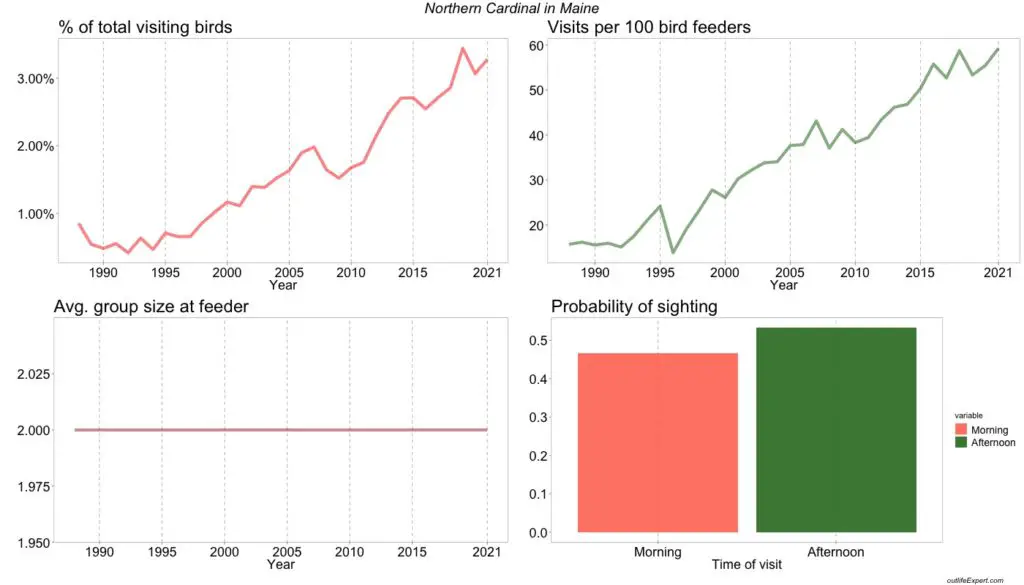
% of total visiting birds: The proportion of the specific bird out of the total number of birds observed bird feeders in this state.
% of total feeders visited: The proportion of feeders (out of all participating feeders in the state each year) where the bird was observed at least once within 2 days.
Avg. group size at feeder: The average number of birds counted simultaneously for each bird feeder observation.
Probability of sighting: The chance of spotting the bird in either morning (before 12 noon) or afternoon (after 12 noon). If both are 0.5 there is an equal chance of spotting the bird in the morning and afternoon.
10. American Goldfinch (Spinus tristis)
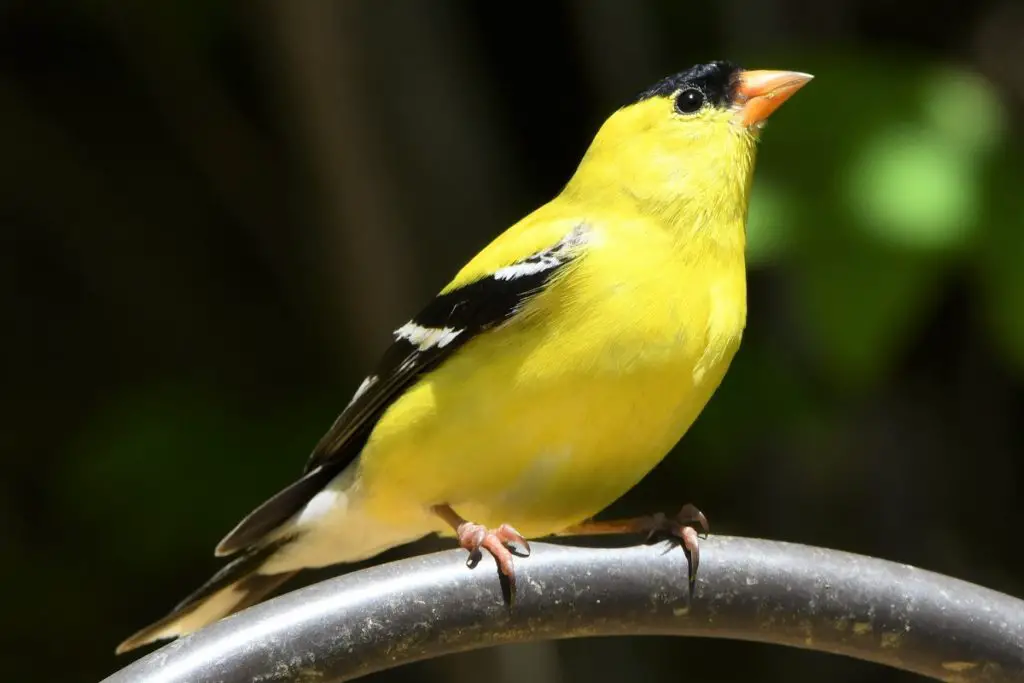
American Goldfinch summary:
Family: Fringillidae
Occurrence: Southern Canada to California in the summer. Also Florida and Mexico in winter.
Diet in the wild: Seeds, insects.
Feeder type preferences:
- Large tube feeder
- Small tube feeder
- Ground feeder
- Large hopper feeder
- Small hopper feeder
- Platform feeder
Feeder food preferences:
- Black Oil Sunflower Seeds
- Hulled Sunflower Seeds
- Nyjer (Thistle) seeds
Endangered: No.
% of Maine feeders visited: 57.7%
Average flock size seen in Maine : 5
% of total birds at Maine feeders: 8%
The American goldfinch is a small garden bird commonly found in large flocks throughout the US, southern Canada, and central Mexico. As short-distance migratory birds, they move south during the winter to escape the cold.
During summer they are found from southern Canada to California and North Carolina. During winter, they can be found from Washington to Nova Scotia south into central Mexico. Their natural habitat is open meadows, but they often flock towards bird feeders in suburban areas. They are the official state bird of three US states: Iowa, New Jersey, and Washington.
The American goldfinch belongs to the Fringillidae (finch) family. There are four subspecies: the eastern goldfinch, the pale goldfinch, the northwestern goldfinch, and the willow goldfinch. Other closely related species include the lesser goldfinch, Lawrence’s goldfinch, and the siskins. Despite the similar sounding name, they are not related to the European goldfinch.
Identifying the American goldfinch
The American goldfinch is a 4 to 6-inch, brown to yellow bird with a white undertail. Their wings and tail are black with white markings. In summer, the male is easily distinguishable with his bright yellow plumage and black cap. The female has a pale-yellow underside in the summer months with an olive-colored head and back. In winter, both males and females are olive-brown with a yellowish head. Juveniles are a dull brown with pale yellow undersides. Their call is a chirpy “tsee-tsi-tsi-tsit”.
Subspecies can be distinguished by their distribution and small variations in coloration and size. The eastern goldfinch is the most common and most eastern subspecies. They occur from Colorado eastwards from southern Canada to central Mexico.
The slightly larger pale goldfinch, as its name suggests, has a paler body, stronger white markings, and a larger black cap in the male. They have a more western range stretching from British Columbia to western Ontario south to Mexico.
The northwestern goldfinch is darker and smaller compared to the other subspecies. They occur along the coastal slope of the Cascade Mountains from southern British Columbia to central California. The willow goldfinch has a browner winter plumage, and in summer, males have a smaller black cap. They are found to the west of the Sierra Nevada range in California southwards into Baja California.
The male lesser goldfinch could be confused with the male American goldfinch but their cheeks and back are olive to black instead of yellow and the black crown of the male covers its entire head. In both males and females, the lesser goldfinch has a yellow undertail, instead of white. The Lawrence’s goldfinch male has a black face and yellow breast, but the rest of its body is grey. Females of Lawrence’s goldfinch have a grey head and back, whereas the American goldfinch has a yellow head and olive back.
Biology
The American goldfinch’s diet consists entirely of seeds. Their breeding season starts in June, when seeds are in greatest supply. Monogamous pairs nest in trees or shrubs. Their nest is an open cup of three inches, woven from plant fibers, bound by spiderwebs and caterpillar silk, and lined with plant down. They will lay four to six eggs, each less than an inch long, pale bluish white, with occasional brown spots.
Attracting the American goldfinch to your backyard
To attract the American goldfinch, you can put out various seeds (especially sunflower and nyjer seeds), and beet greens. Use a feeder designed for smaller birds, because large birds at the feeder could discourage the American goldfinch. During the breeding season, you can put out 100% cotton for them as nesting material. Plant indigenous grasses, sunflowers, thistles, dandelions, coneflowers, milkweed, zinnias, and large trees in your garden. A bird bath or water feature would provide an additional attraction.
Is the american goldfinch endangered?
The American goldfinch is listed as least concern since its population is generally increasing across the United States. However, climate change could cause southern contractions in their distribution with local extinctions in various states, due to the increased risks of heatwaves and heavy rainfall endangering their eggs and chicks.
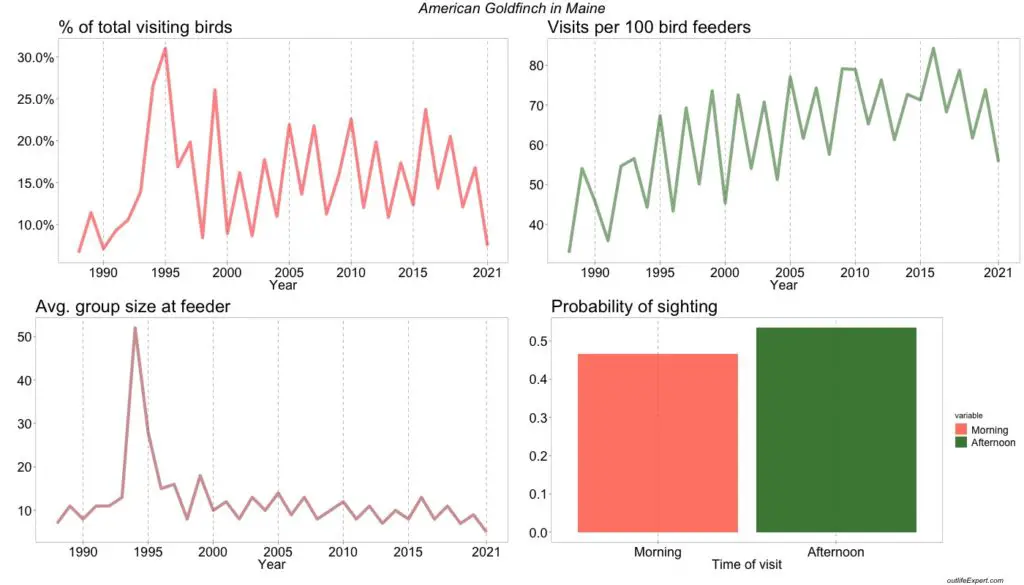
% of total visiting birds: The proportion of the specific bird out of the total number of birds observed bird feeders in this state.
% of total feeders visited: The proportion of feeders (out of all participating feeders in the state each year) where the bird was observed at least once within 2 days.
Avg. group size at feeder: The average number of birds counted simultaneously for each bird feeder observation.
Probability of sighting: The chance of spotting the bird in either morning (before 12 noon) or afternoon (after 12 noon). If both are 0.5 there is an equal chance of spotting the bird in the morning and afternoon.
Backyard birds in other states
Are you interested in how the backyard birds in your state compare to other states?
Then check out my other blog posts below:
- Backyard birds of Alabama
- Backyard birds of Colorado
- Backyard birds of Delaware
- Backyard birds of Georgia
- Backyard birds of Hawaii
- Backyard birds of Illinois
- Backyard birds of Iowa
- Backyard birds of Kentucky
- Backyard birds of Louisiana
- Backyard birds of Maryland
- Backyard birds of Massachusetts
- Backyard birds of Missouri
- Backyard birds of Nebraska
- Backyard birds of New York
- Backyard birds of North Carolina
- Backyard birds of Oklahoma
- Backyard birds of Rhode Island
- Backyard birds of South Carolina
- Backyard birds of Tennessee
- Backyard birds of Texas
- Backyard birds of Virginia
- Backyard birds of West Virginia
- Backyard birds of Wisconsin
- Backyard birds of Wyoming
And in Canada:
- Backyard birds of Ontario
- Backyard birds of Prince Edward Island
- Backyard birds of Saskatchewan
- Backyard birds of Quebec
Not on the list? Check out the rest of my posts on backyard birds here!
Maybe you would like to know if the Blue Jay or Cardinal dominates in the bird feeder hierarchy or how birds such as seagulls sleep at night? Or why mourning doves poop so much and whether most birds can poop and fly at the same time!
A lightweight handy pair of binoculars is a must for your backyard bird watching! Check out my recent post on the best small lightweight binoculars for birdwatching etc.
My Favorite Backyard Birding Gear:
- Photographs and identifies birds coming to your bird feeder!
- Notifies you via the app whenever a bird stops by!
- Excellent resolution and battery performance with the 6MP image sensor.
- Connect from anywhere with internet access (watch birds even when you are not at home!)
- Count the birds visiting your feeder and contribute to projects such as FeederWatch!
If you are interested in posters and other wall arts etc. with drawings of all the backyard birds you have just read about, check out my portfolio over at Redbubble:
Acknowledgements
I want to thank the Cornell Lab of Ornithology at Cornell University and the Birds Canada organization as well as all the citizens who have been involved in the FeederWatch project for providing the data of this article. The data I have used to generate the prevalence numbers for this article is provided by the FeederWatch project. The FeederWatch project is an initiative by The Cornell Lab of Ornithology at Cornell University and the Birds Canada organization. The data is collected through an immense crowdsourced citizen science program, where citizens of the United States and Canada are invited to count birds at their bird feeders, identify the species, and report back to the scientists at Cornell University. The birds are counted from November to April and always in two consecutive days including only one area with a bird feeder, typically a piece of the backyard, observed from one vantage point. The two-day watch is then repeated throughout the season. The data is collected each year and is freely available to the public at https://feederwatch.org/.
References
American Museum of Natural History Birds of North America. DK; Revised edition (September 6, 2016). ISBN: 978-1465443991
National Geographic Backyard Guide to the Birds of North America, 2nd Edition. National Geographic; 2nd edition (October 15, 2019)
Birds of North America. National Audubon Society. (Knopf April 6, 2021). ISBN: 978-0525655671







